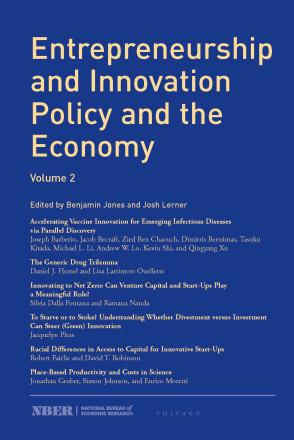Entrepreneurship and Innovation Policy and the Economy, volume 2

Entrepreneurship and innovation are widely recognized as key drivers of economic dynamics and long-term prosperity. This series communicates new findings about the determinants and implications of entrepreneurial and innovative activity across the economy. In the first paper, Joseph Barberio, Jacob Becraft, Zied Ben Chaouch, Dimitris Bertsimas, Tasuku Kitada, Michael Li, Andrew Lo, Kevin Shi, and Qingyang Xu measure pharmaceutical firms’ incentives to develop vaccines against prospective diseases, and document the high investment risks, low expected returns, and the rarity of pandemics. They analyze a portfolio approach to financing vaccine research. Next, Daniel Hemel and Lisa Larrimore Ouellette describe the tradeoffs between quality, price, and access that arise after a generic pharmaceutical’s patent expires, and explore the implications of these tradeoffs for regulatory policy. The third paper, by Silvia Dalla Fontana and Ramana Nanda, examines the role of patents in the transition to a carbon-free world. The researchers find that although “net zero patents” are close to the scientific frontier, difficulties in commercializing inventions has resulted in a low level of funding from venture capitalists. Jacquelyn Pless examines the effects of divestment from firms in carbon-intensive businesses on innovation, and concludes that investing in firms and engaging with green corporate governance practices may induce more green innovation than divestment. Next, Robert Fairlie and David Robinson find that Black-owned innovation-intensive businesses are smaller when launched, and do not converge in size over time, to comparable business owned by members of other groups. They attribute this to differential access to bank financing as well as “soft information” that can be important in the start-up process. Finally, Jonathan Gruber, Simon Johnson, and Enrico Moretti consider the regional concentration of innovative activity in the United States, pointing out that while the concentration of activity yields short-run advantages, there may be long run benefits of more diffuse innovation clusters including equity, industrial diversification, and talent development.


